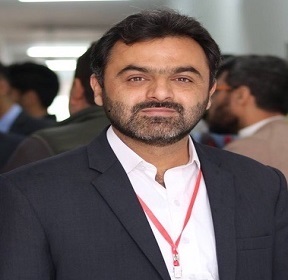Speakers
Taherah Mohammadabadi
University of Khuzestan IranTitle: Camel milk; A unique superfood for diabetic patients
Abstract:
There are various anti-diabetic drugs to treat diabetes but they have several negative effects on the patients’ health. Although the proper treatment of diabetes includes insulin injection continuously to maintain blood glucose level, but nowadays, the researchers following some natural alternative healings for insulin. Camel milk contains insulin like proteins, which does not form coagulum in the acidic condition of stomach, can be absorbed from the intestine and may be an effective alternative for insulin to treat type 1 and 2 and gestational diabetes. Camel milk is believed to be a suitable hypoglycemic agent in improving long-term glycemic control in experimental animals and patients with diabetes. The incidence risk of diabetes in people who regularly consume camel milk, is much lower than those who don’t use camel milk. Camel milk may prepare about 60% of the insulin in diabetic patients and reduce blood sugar and required insulin dose about 30–35% in type 1 diabetes patients. Raw camel milk has immune- modulatory effects on beta-cells of the pancreas, increase insulin secretion, reduces required insulin and insulin resistance and improves the glycemic control in type 1 diabetes patients. Camel milk improves the diabetes complications such as obesity, inflammation, wounds and oxidative stress damages. Lactoferrin of camel milk has immune- modulatory effects on pancreas beta-cells and reduces required insulin doses in diabetes 1 and 2 patients. Obviously, camel milk effects on regulating of blood glucose are including; effect on insulin receptor function, signaling and glucose transport in the insulin-sensitive tissues, effect on the growth and activity of the pancreatic beta-cells in insulin secretion and negative modulation on the glucagon receptor. In most of the clinical trials, the favorable effects of raw camel milk on diabetes mellitus observed by the recommended dose 500 mL/day for 3 months which also improve risk factors in diabetic patients. It appears that more scientific studies are needed to confirm the effectiveness of processed and camel milk powder on diabetes cases.
Keywords: Insulin like protein, diabetes, camel milk
Biography:
Taherah Mohammadabadi finished her PhD in Iran and Australia and has been as a researcher at University of Queensland, Australia; she has attended and presented her works in different conferences in some countries. She is working as academic member, researcher and teacher since 11 years ago in Faculty of Animal Science and Food Technology, Agricultural Sciences and Natural Resources University, Iran. She has been as supervisor for 10 PhD students and more than 30 Msc students. She has over 200 published publications, conferences presentations, and scientific projects; Also, some books on phytochemicals and microbes, bioactive components in the livestock milk; milk lactoferrin and health, anti-diabetes properties of camel milk. She is member of the editorial board and reviewer of some international and national journals.
Jimmy Nkaiwuatei
Jomo Kenyatta University KenyaTitle: The use of genetic interference mechanisms in treatment of human genetic disorders
Abstract:
Gene interference can be defined as the alteration of the activity of specific genes by altering the regulatory sequences. Gene therapy aims at treating genetic diseases through insertion and expression of specific exogenous genetic materials by transfer of nucleic acids either in vivo or in vitro (through modified cells). This results to expression of a normal product thus correcting the abnormal cellular function. Gene therapy involves two approaches which include germ-line and somatic line gene therapy. In germ-line gene therapy, the germ cells are integrated by exogenous functional genes which can be transferred into the offspring’s while in somatic line gene therapy, the genes are introduced into the patients’ somatic cells and the effects are only experienced on that particular individual. Both methods leads to reduction in the coding mRNA levels. RNA interference not only inhibits transcription, but also induces an RNA degradation process. Gene silencing is enhanced by presence of double stranded RNA (dsRNA) molecules and is initiated by the dicer enzyme, where the dsRNA are cleaved by the protein into small interfering RNA (siRNA) strands which can prime the mRNA of the coding genes to form a duplex (siRNA + mRNA). The duplex activates the RNA-induced silencing complex (RISC) which upon activation degrades the duplex with the critical coding sequences. This is very essential in gene silencing. This gene degradation mechanism thus blocks the process of translation thus inhibiting expression of abnormal proteins responsible for the genetic diseases
Biography:
Jimmy Nkaiwuatei holds a Bachelor of Science in Biochemistry and Molecular Biology from Jomo Kenyatta University of Agriculture and Technology (JKUAT), Kenya. He is the founding Partner, of the Find Your Voice Science club and is currently the head of the Drug Research, Discovery, and Innovations Program at Students against Superbugs Africa. He is also a member of the Young African Leaders Initiative (YALI).
Najeeb Ullah
University of Agriculture PakistanTitle: Significant association of BRCA1, BRCA2 and TP53 gene polymorphisms with breast cancer risk in Khyber Pakhtunkhwa, Pakistan
Abstract:
Background: Molecular characterization of breast cancer heterogeneity facilitates the understanding of disease etiology and progression. More specifically, mutations in known and tumor suppressor genes such as BRCA1, BRCA2 and TP53, result in the alteration of a genomic landscape within sporadic and familial breast cancers. Single nucleotide polymorphisms (SNPs) are described as a mutation with a particular prevalence in certain ethinic population that in turn result in the altered prevalence of disease, the tumor suppressor genes responsible for maintaining the genomic stability. Certain SNPs in BRCA1, BRCA2 and TP53 are known to correlate with elevated risk of breast cancer development worldwide, however there is no such study categorizing the risk of breast cancer development in the Khyber Pakhtunkhwa population in Pakistan.
Objectives: We investigated known associative SNPs on the following risk alleles, BRCA1 (rs1799950), BRCA2 (rs144848) and TP53 (rs1042522) to determine the prevalence of these genetic elements within the Pakhtunkhwa population, and to further stratify the risk of breast cancer risk development conferred by such polymorphisms in the same population.
Methods: To determine the prevalence of known breast cancer associated SNPs, a total of 220 DNA samples were collected via venipuncture procedure. Out of 220, 140 of the samples were obtained from breast cancer patients and 80 were considered age and gender matched healthy controls. Genomic DNA was extracted from the peripheral blood cells and genotyping was performed utilizing a T-ARMS PCR technique. The frequencies of the polymorphisms were checked using SPSS version 16.
Results: Our results indicated that risk alleles of all three selected SNPs showed statistically significant association with breast cancer presence, p<0.05 (BRCA1, C- p=0.001); (BRCA2, C- p=0.000) and (TP53, C- p=0.000). Similarly, all the genotypes carrying risk allele were also significantly associated with the breast cancer risk with p<0.05 (BRCA1, TC- p=0.037, CC- p=0.005); (BRCA2, AC- p=0.000, CC- p=0.000) and (TP53, GC- p=0.000, CC- p=0.000).
Conclusion: The risk allele and risk allele containing genotypes showed statistically significant association with breast cancer risk in our region. More investigation will be required to disseminate the results with large data sets and using whole genome sequencing.
Key words: Breast cancer risk, BRCA1, BRCA2, TP53, Polymorphisms
Biography:
Najeeb Ullah Khan has a Ph.D. in Biochemistry and Molecular Biology. Recently, He is working on human genetic variability and susceptibility to cancer. His focus is to find the most associated gene polymorphism with cancer risk in our region and check the potential of that particular gene polymorphism as a biomarker for disease monitoring, especially cancer early diagnosis, particularly breast cancer. So far, they have confirmed the association of BRCA1&2, TP53, RANKL, OPG, IL-6, HER2, etc) polymorphisms with breast cancer risk in our population (Pashtun ethnicity). Several other related studies are under process in breast and other cancer including the association of noncoding RNA (microRNAs) with cancer risk. Interested in any kind of research collaboration in the field of cancer Biology, cancer genetics and cancer early diagnosis.
Poster
Aparajita Kumar
Max Hospital IndiaTitle: Optimal duration of dual antiplatelet therapy after angioplasty and the DAPT score
Abstract:
Background: The benefits of dual antiplatelet therapy with aspirin and a P2Y12 receptor antagonist (DAPT) in Acute coronary Syndrome and those undergoing percutaneous coronary interventions have been clearly established as a standard of care. However, the duration of use of dual antiplatelet therapy after Percutaneous coronary intervention is evidence-based, and the optimal duration is often arbitrary and unclear. The ACC/AHA and the European Society of Cardiology guidelines published between 2011 and 2014 recommend a minimal 12 months of dual antiplatelet therapy in most patients with DES implantation. Prolongation of dual antiplatelet therapy beyond one year of Percutaneous Coronary Intervention may be beneficial by way of decreased incidence of atherothrombotic events including recurrent Myocardial infarction or stent thrombosis but at the cost of increased risk of major or minor bleeding.
The PEGASUS TIMI 54 trial showed that the addition of the P2Y12 antagonist ticagrelor to low-dose aspirin in patients 1 to 3 years after a myocardial infarction significantly reduced the rate of major adverse cardiovascular outcomes. Aspirin monotherapy alone has at best modest antiaggregatory activity on platelets, especially in the acute phase in high-risk patients to prevent ischaemic events; since it only inhibits the cyclooxygenase pathway whilst having no effect on the adenosine diphosphate P2Y12 receptor. Combination therapy results in more robust inhibition of platelet aggregation. This was established by the CHARISMA trial, which demonstrated significant benefit in reduction of myocardial infarction, stroke, repeat revascularisation, and death in patients at high risk of ischemic events /established vascular disease who received clopidogrel along with aspirin.
Continual dual antiplatelet therapy beyond one year after index PCI is common despite the dilemma of benefit/risk ratio to the patient. The PARIS registry showed that in a cohort of 5031 patients, 43%of patients with ACS and 57% of those undergoing elective PCI remained on DAPT at the end of 2-year follow-up. It has been proposed that the DAPT score can aid in individualizing antiplatelet therapy, and identify those who actually benefit from a prolonged regimen of dual antiplatelets.
Objective: To evaluate the rationale for continual Dual antiplatelet therapy beyond one year after index PCI, and to correlate it with the DAPT score.
Methods: 500 patients who underwent PCI at our center with a final diagnosis of ST Elevation Myocardial Infarction, Non-ST Elevation acute coronary syndrome, or stable ischemic heart disease, and were compliant with antiplatelets were evaluated and followed up for at least one-year post PCI. The type of thienopyridines prescribed in addition to aspirin was noted for each patient; along with any concurrent oral Vitamin K antagonists/novel oral anticoagulants prescribed. Exclusion criteria remained those patients who were lost to follow-up, those who expired in hospital, and those who underwent only plain old balloon angioplasty and were not stented. The DAPT and HASBLED scores were used as risk stratification methods to assess ischaemic and bleeding risks. The indication for percutaneous intervention, size of stents used,and whether it was a drug eluting stent or bare metal stent was noted. History of restensosis or prior stenting or CABG was taken.Prexisting comorbidities such as diabetes,hypertension,hypercholesterolemia,prior myocardial infarction ,prior cardiac surgery and previous cerebrovascular accident or transient ischaemic attack were taken into account.The primary endpoints were non fatal recurrent Myocardial infarction,stent thrombosis,non fatal ischemic CVA ,repeat revascularisation or death.The primary safety endpoints included major and/or minor bleeding,and the need for blood transfusion.
Results: Of all the eligible patients receiving dual antiplatelets followed up,292( 58.4%) were diabetic,233 (46.6 % )were hypertensive ,267 (53.4%) were dyslipidemic while 62(12.4%) were smokers.292(58.4%) had presented as STEMI,73(14.6%) had NSTEMI, while 24(4.8%) had restenosis,1 patient had subacute stent thrombosis and remaining 47(9.4%) had stable angina,32(6.4%) had Left Main Coronary Artery disease,55(11%) had bifurcation lesions,16(3.2%) underwent Saphenous Vein Graft stenting, 5(1%) had chronic total occlusion; and 100 patients had stents longer than 28 mm.103(20.6%) had 2 or more stents.41(8.2% )were on aspirin monotherapy at the end of 1 year after PCI,9(1.8%) were on clopidogrel alone,1 patient was on prasugrel monotherapy ,while majority 212(42.4%) were on a combination of aspirin and clopidogrel;7 (1.4% )were on aspirin and ticagrelor,14/2.8% were on aspirin plus prasugrel .Furthermore,3(0.6%) patients were on concurrent oral Vitamin K antagonists(warfarin/acenocoumarol) and 1 patient was on NOAC(dabigatran) for thromboprophylaxis of atrial fibrillation/intracardiac thrombus/recurrent CVA/previous prosthetic valve.96(19.2%) had a HASBLED score of 3 or more,while 28/5.6% patients had HASBLED score higher than 4. 234/46.8% had a DAPT score greater than or equal to 2.35/7% had LV ejection fraction <45%,and 23/4.6% had prior history of CHF.60/12% had a prior myocardial infarction,10/2% had prior CVA,19/3.8% had recent MI. 12/2.4% had bleeding complications within one year.36(7.2%) had prior PTCA,15(3% )had undergone prior CABG.
96/ 19.2% had MACE, of which 46/9.6% underwent repeat PCI,27/5.4% had recurrent MI,7 patients (1.4%) had stent thrombosis,7/1.4% patients had ischemic CVA within one year of PCI,9/1.8% expired.6/1.2% had history of Subdural hematoma,8/1.6% patients had intracranial bleed,13/2.6% patients had GI bleeding;while 7/1.4% had non GI bleeding like epistaxis/hematuria.14/2.8% patients required blood transfusions .None of the patients had fatal bleed.23/4.6% had underwent emergency surgeries,and 24 patients underwent elective surgeries.
Of the 41 patients on aspirin monotherapy,8(19.5%) had MACE,of which 26 underwent repeat PCI,and 3 expired,whilst 11/2.2% patients had bleeding;as opposed to 9 patients on clopidogrel alone,of which 2 had MACE(22.2%),including one death, and 5/7% patients had GI bleed.
Discussion: Dual antiplatelet therapy in patients treated with coronary stent implantation reduces the risk of ischemic events and stent thrombosis in atherosclerotic cardiovascular disease.The current recommended period of dual antiplatelets based on observational data after DES implantation is 12 months;whilst after BMS implantation is 1 month. The PCI CURE analysis showed that dual antiplatelet therapy upto 12 months in patients with NSTEMI treated with BMS reduced ischemic events compared to aspirin monotherapy.The Dual Antiplatelet Therapy trial also demonstrated that patients who underwent stenting with DES who were treated on extended dual antiplatelet regimen had 0.7% absolute reduction in late stent thrombosis ,2 % absolute risk reduction in MI and 1.6% risk reduction in MACE after index PCI , with a fundamental tradeoff of 1.2% increased risk of moderate/severe bleeding. Furthermore,post hoc analyses from other studies implicated greater benefit with prolonged intensive antiplatelet therapy.A weighted risk-benefit analysis by the ERC of prior studies of patients revascularised with DES showed 6 lesser myocardial infarctions and 3 fewer stent thromboses,but 5 additional major bleeding per 1000 patients on prolonged DAPT annually.Prolonged DAPT regimen was defined as 18 to 36 months after DES implantation.
The results of our analysis shows almost comparable rates of Major Adverse Cardiovascular outcomes in both arms of single and dual antiplatelet therapy,with greater incidence of bleeding observed on dual antiplatelet regimen.Lifelong DAPT in patients undergoing DES revascularisation is unwarranted, as the risks of bleeding and cost of prolonged treatment outweighs potential reduction in stent thrombotic events.
Nevertheless,12 months of DAPT is reasonable after DES implantation, although treatment should be individualised based on presence of ischemic risk factors,the anatomical complexity of lesion,and the type of stent implanted.Abbreviated thienopyridine therapy may be considered in the event of significant bleeding risks;including concurrent oral vitamin K antagonist usage,and anticipated surgery.
Biography:
Aparajita Kumar completed their Diploma in Cardiology in 2015 from MS Ramaiah Narayana Hrudalaya, Bangalore, and is an International Associate, at the American College of Cardiology. She has over 7 years of experience in Cardiology having previously worked in leading corporate hospitals, and is presently working as Consultant Cardiology-Non interventional in Max Hospital Dehradun, India. She has attended several national and international conferences and has been a presenter at International Trauma Conference. She had been awarded Second prize in National Young Genie Champion in Cardiology in 2016. She has a keen interest in research, and completed Research to Publication course by UCMS California and BMJ for designing clinical trials and scientific writing, and was awarded 200 CPD credits for the same. Her key interests are Preventive cardiology, echocardiography, and hypertension.
Video Presentation
Shruti Dabi
Rajasthan University of Health Science IndiaTitle: Comparative evaluation of role of Oro-t mouthwash and Smf mouthwash as adjunct to scaling (subgingival irrigation): A randomized clinico-comparative study
Abstract:
Introduction: Treatment of periodontal disease is routinely based on mechanical debridement of the tooth surface and appropriate and meticulous maintenance of oral hygiene. However, comprehensive mechanical debridement of sites with deep periodontal pockets is difficult to accomplish, therefore systemic or local administration of antibiotics are preferred. But there are various disadvantages with systemic therapy like hypersensitivity reaction, organ toxicity and bacterial resistance. So, to attained the correct required GCF concentration at the target site, led to the use of local drug-delivery system. Ayurveda system of medicine has its root in Indian subcontinent which is being globalized and practices as alternative medicine in the Western world. It is typically based on complex herbal compounds, minerals, and metal substances. Further SMF mouthwash has been used for treating OSMF patient because of its contents which enhanced its properties by improving healing capacity of the tissue. So, in this present study we have planned to evaluate & compare healing potential of both the mouthwashes which is better.
Aim:Comparative Evaluation of Subgingival irrigation Role Of ORO-T Mouthwash and SMF Mouthwash as adjunct to scaling. A clinical comparative study.
Objective
- To evaluate effect of subgingival irrigation ORO-T mouthwash as an adjunct to scaling & root planning (SRP).
- To evaluate effect of subgingival irrigation SMF mouthwash as an adjunct to scaling & root planning (SRP).
- To compare & evaluate effect of subgingival irrigation ORO-T mouthwash & SMF mouthwash as an adjunct to scaling & root planning (SRP).
Materials: Piezoelectric scalers, Oro-t mouthwash, SMF mouthwash,5 ml syringe with blunt cannula. TYPE OF STUDY- A Randomized Clinico-Comparative Split Mouth Study. SAMPLE SIZE- Split mouth study in 30 patients with 120 experimental sites with inclusion criteria involving like Systemically healthy patients, Periodontal pocket depths ranging from ≥5 mm to ≤ 7mm, Requiring Non- surgical periodontal treatment and exclusion criteria involving like patients taking antibiotics for past 6 months, Smokers /Gatka or any form of smokeless tobacco users, Periodontal therapy within past 6 months, Bony defect requiring surgical regenerative treatment and Mobility. Clinical parameters Plaque Index, Gingival Index, Bleeding Index, probing depth, Clinical attachment level were recorded at baseline, at day 14 & day 21 & were evaluated for both Oro -t mouthwash &SMF mouthwash group after giving subgingivally as a local drug delivery as an adjunct to scaling & root planing.
Result: Statistically significant reduction was seen for all the parameters in both the groups when compared with baseline parameters but there was no statistically significant difference between Oro-t mouthwash & SMF mouthwash.
Conclusion: Although there was no statistically significant difference between Oro-t mouthwash & SMF mouthwash in all the parameter’s reduction yet SMF mouthwash can be used as a local drug delivery in replacement of antibiotics (tetracycline fibers) because of its superior properties when compared with turmeric mouthwash. Further researches need to be done.
Keywords-Oral Submucous fibrosis, Clinical attachment level, Oro-T mouthwash, Local drug delivery.
Biography:
Shruti Dabi. have completed my master in dental surgery in the year Aug, 2021 from Rajasthan University of health science, Jaipur (Raj.). Presently She is practicing her field of specialty in her private clinic held in Ajmer (Raj.) India with her dad’s named as Vikram Singh Dabi. She had published 2 original research in international PubMed journals & 1 book in international journal, others are under process. Presently She is working with 4 different journals, as an Editor in 2 international journals [1 dental (PubMed journal) & 1medical (Scopus journal)] & as a Reviewer in 2 international dental journals (Scopus, publons).





